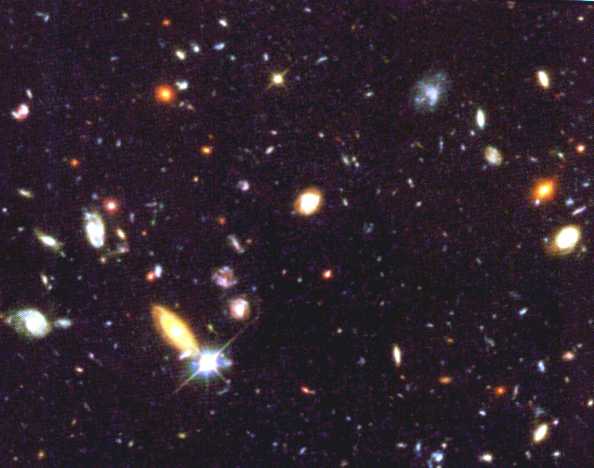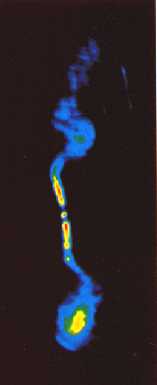
|
|
|
|
|
|
|
The
First Stars and Galaxies
There is a veil of mystery in gradual dissipation that
still prevents cosmologists from getting a clear idea about how the small temperature fluctuations resolved
by COBE (Cosmic Background Explorer) in 1992 evolved in order to form the
first galaxies.
Galactic
Genesis
In an earlier stage there would have been a
gravitational collapse of regions whose densities assumed values above the
average.
Galactic Aggregation
Concerning to what happened later, among the theories
that were proposed to explain the origin of the observed structure, the
so-called "down-up model" ended up prevailing: sub-galactic masses or
mini-galaxies merged into galaxies that, in the end, accreted to form galaxy
clusters. This model is more consonant with a cold and slow dark matter scenario, which
favours an initial aggregation of matter in minor objects that later aggregate
in larger massive bodies. However, this model may also be consistent with a hot
dark matter scenario, since we assume the possibility of the existence of cosmic strings.
The aggregation process would have been easy in a
smaller Universe, where galaxies were tighter than they are today. The
frequency of the collisions between them can explain their predominantly
irregular shapes.
Stone Age Galaxies
In recent observations were detected the most
primitive galaxies, formed only 600 million years after the Big Bang, under the
form of future elliptical galaxies cores and components
(namely central bulges) of the future spiral galaxies.
These ancient galaxies are characterized for being
surrounded by hydrogen envelopes that absorb ultraviolet radiation produced by
stars and, therefore, making them invisible in this segment of the spectrum.

The first galaxies of
the Universe (HST - NASA)
The
First Stars
The ignition of the earliest stars - Population III -
was the responsible factor for a period of re-heating of the Universe, during
which the dust clouds previously expelled by the explosions of similar bodies
absorbed and re-emitted a huge quantity of the radiation produced by those
enormous stars. This period is known as the "re-ionization age".
These stars would be ignited in clouds holding more than 1 million solar
masses, inside completely black proto-galaxies whose diameter wouldn't be
larger than 2000 light-years.
The Population III stars would be systematically
heavier than the current ones (holding between 100 and 1000 solar masses),
since they would have been formed exclusively by helium and hot atomic hydrogen
(not molecular, given the absence of agglutinating metals). For that reason,
they would have had a very quick evolution and none of them would have survived
until today.
A small metallic content (carbon and other elements
heavier than helium) fused inside these stars would have been scattered by the
gigantic supernovae (called
hypernovae) that put an end to their lifes. This content would be further
incorporated in a second generation of stars - the Population II, which
includes the stars of the galactic bulges and halos. These hypernovae were
responsible for the incredibly energetic gamma-ray bursts observed in very
distant galaxies.

Two surprisingly near
remnants of gamma-ray bursts, close to the M101 galaxy (HST-NASA)
Who Came First: Stars vs. Black Holes
Two possible scenarios are considered to enlighten what
may have been the galactic childhood:
Quasars
and Active Galaxies
Among the most ancient and brightest objects of the
whole Universe there are the quasars, 100 times more luminous than a normal
galaxy. It's thought that they are the cores of young and extremely active
galaxies that are appeased today. There are two kinds of quasars: those that
are identified with strong radio emissions and those where those emissions are
relatively absent.
The Origin of the Radiations
It's estimated that the very powerful light emissions in most of
the spectrum segments (reaching up to 10 trillion times the solar emission) are
originated by an enormous black hole containing about 100
million solar masses and absorbing big quantities of matter (1 to 2 solar
masses each year). 10% of this matter is converted into energy during the
process.
The radio waves are proceeding from a synchrotron,
which is a whirlwind created by the orbit of charged particles (mainly electrons)
around a magnetic field, swirling it at a velocity compared to the light speed. The process is
similar to what happens in neutron stars or in other active
galaxies. These plasma jets would be headed to the directions of the magnetic
fields, approximately perpendicular to the disk plane. These magnetic fields
accelerate the jets, which this way avoid the strong resistance of the thick galactic disks.
The absorption of the energy generated in the centre
of the quasar by the dust clouds existing in the
host galaxy and subsequent re-emission in infrared will be, on its turn, the
responsible mechanism for the radiation that are observed in that segment.
On the other hand, the radiation in the visible and
ultraviolet segments would be emitted by a disk of matter (called accretion
disk) spiraling at high speeds around the central object and freeing big
quantities of energy as this disk would be sucked.
The x-rays are thought to be proceeding from a region close
to the central black hole (possibly the synchrotron or the zone of production of electron/positron
virtual pairs), being absorbed and re-emitted by the accretion disk.

Electromagnetic spectrum, from the gamma
radiation to the radio waves (MoonRunner Design UK)
Life Expectancy of a Quasar
It's estimated that the average life expectancy of a
quasar is between 10 and 100 million years. It's also conjectured that in the
primitive Universe, which was wealthier in gases and a stage for more frequent
galactic collisions (given the higher density of the matter), the arising of
quasars would have been very much eased. For this reason, the big majority of
the quasars are observed at big distances, at the early Universe.
Other Active Galaxies
It's still worth to mention 3 objects that are analog
to quasars, which are believed to also result from high activity levels in the
core of the galaxy:

Radio source 3C 449
(Ediciones Orbis - Astronomia)
_